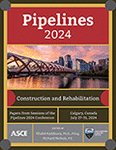Confronting the Complexities of Large-Diameter Sewer Rehabilitation in a Highly Urbanized Setting
Publication: Pipelines 2024
ABSTRACT
Urbanized areas around the globe face an increasingly urgent need to rehabilitate aging sewer infrastructure. Challenging projects in dense neighborhoods have long been deferred for their difficulty and are now rising to the top of the list of priorities. The Boston Water and Sewer Commission (BWSC) is undertaking a multi-year, multi-phase program to rehabilitate one of its most critical sewer interceptors. The New Boston Main Interceptor (NBMI) conveys sewage and stormwater from more than 3,000 tributary acres, including downtown Boston and multiple other district neighborhoods. The 102-in. reinforced concrete pipe is experiencing significant corrosion from hydrogen sulfide gas. This paper focuses on the unique complexities faced in large-diameter sewer rehabilitations within a dense urban fabric—including working within congested utility corridors and major commuter transportation corridors, minimizing neighborhood impacts, and anticipating the needs of many stakeholders. The goal of this project is to achieve a robust structural rehabilitation solution while minimizing hydraulic impacts to the network, construction impacts to the neighborhood, and local traffic. Trenchless techniques are optimal for urbanized settings, because they minimize excavation which, in this case, would be an average 30-ft deep excavation along a major residential/commercial street and would cause significant neighborhood disruption. In this instance, sliplining and geopolymer application were the preferred rehabilitation methods for this vital venture due to the significant corrosion, large interceptor size, bypassing design, and barriers to excavation. By early 2024, Phase 1 rehabilitation will be completed, Phase 2 rehabilitation will be under construction, and Phase 3 design will be 50% complete. BWSC employed complex bypass strategies for varying flow conditions, adapted lining practices to suit this unique project (e.g., slipline grouting into a tight annular space and field measuring ovality of spray liner), minimized excavation and utility conflicts through the use of existing access points and structures, and minimized traffic impacts with a narrow work zone. We will highlight these and other strategies that can prove beneficial to owners and engineers undertaking similar rehabilitation efforts in highly urbanized settings worldwide.
Get full access to this chapter
View all available purchase options and get full access to this chapter.
REFERENCES
Alavi, A., Guercio, N., Kazi, N., McSweeney, I., and Salvatore, P. 2023. Decision Making Process for the Sewer Pipe Liner Evaluation. ASCE Pipelines Conference, 2023.
NOAA (National Oceanic and Atmospheric Administration), NWS (National Weather Service), Hydrometeorological Design Studies Center, and Precipitation Frequency Data Server. NOAA Atlas 14 precipitation frequency estimates, <hdsc.nws.noaa.gov>(accessed December 2023; last modified April 2023).
Information & Authors
Information
Published In
History
Published online: Aug 30, 2024
ASCE Technical Topics:
Authors
Metrics & Citations
Metrics
Citations
Download citation
If you have the appropriate software installed, you can download article citation data to the citation manager of your choice. Simply select your manager software from the list below and click Download.
